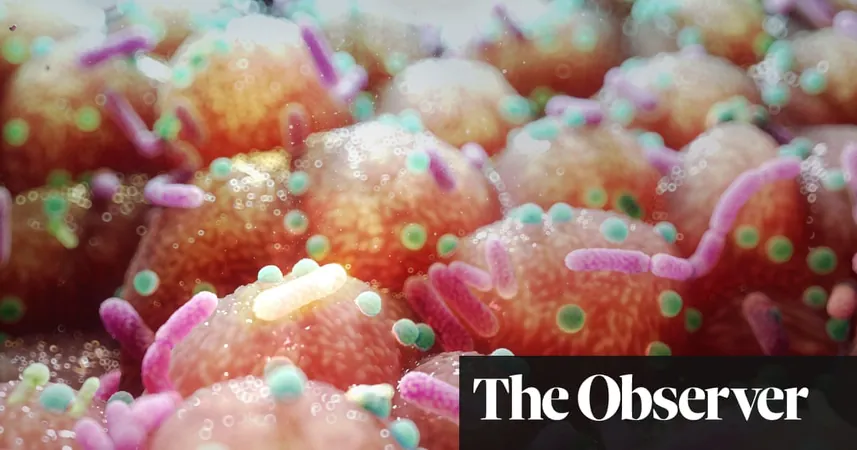
The Antibiotic Catastrophe: 40 Million Lives at Risk in Next 25 Years!
2025-01-05
Author: Li
Introduction
The alarm bells are ringing loud and clear: we are facing a looming antibiotic crisis that could claim up to 40 million lives globally over the next quarter-century. Dame Sally Davies, former chief medical officer for England, has stepped into the spotlight to warn us of the terrifying implications of this growing threat.
The Danger of Antimicrobial Resistance (AMR)
According to Davies, this crisis could render routine medical procedures—ranging from surgeries to childbirth—life-threatening due to the rapid spread of antimicrobial resistance (AMR). Currently, approximately one million people die each year due to AMR, but this figure is expected to rise sharply, with estimates indicating that death rates from these superbugs will double by 2050, placing the elderly at particular risk.
Vulnerable Populations
Despite some positive developments, such as decreasing AMR rates in children under five, alarming statistics reveal that mortality rates among the over-70 demographic have spiked by a staggering 80% since 1990. This trend highlights the vulnerability of older adults, many of whom suffer from chronic illnesses that heighten their susceptibility to resistant infections.
Antibiotic Use in Agriculture
Efforts to combat AMR have been met with urgency; physicians have been under increasing pressure to restrict antibiotic prescriptions, while patients are urged to complete their treatment courses. But the problem extends far beyond medical practices. Davies points to the agricultural sector, stating that around 70% of antibiotics produced are administered to livestock as cost-effective growth promoters and disease prevention measures. This indiscriminate use fosters an environment where resistant bacteria can thrive, posing a significant risk to humans.
Environmental Impact of AMR
The consequences are far-reaching. In environments like intensive farms or poorly managed hospitals, resistant bacteria can escape into waterways, contaminating broader ecosystems. "Winds can carry these resilient bacteria and genes across vast distances, dispersing them to other areas," Davies explained, illustrating the insidious nature of AMR.
Bacterial Adaptation and Resistance
Bacteria are quick to adapt and reproduce—doubling in number every 20 minutes—making them formidable opponents. If they encounter antibiotics and develop mutations that confer resistance, they not only thrive but can also transfer this resistance to other bacteria, exacerbating the crisis.
Stagnation in Antibiotic Development
Compounding the urgency of the situation is the stagnation in antibiotic development. Davies notes that no new classes of antibiotics have been introduced since the late 1980s, highlighting a broken market model that fails to incentivize pharmaceutical companies. New antibiotics might see limited use, contrasting sharply with daily medications for chronic conditions that provide far greater profit margins.
Call to Action
The fight against AMR is daunting, but not impossible. Davies emphasizes the need for immediate, coordinated action. While global forums like the G7 acknowledge the seriousness of the situation, tangible measures remain woefully inadequate. Without a collective push towards addressing the AMR crisis effectively, the stakes will continue to rise, possibly jeopardizing millions of lives in the foreseeable future.
Conclusion
As we stand on the brink of this public health catastrophe, one must wonder: How prepared are we to face an enemy enhanced by our own actions? The answer may be the difference between life and death for millions.


 Brasil (PT)
Brasil (PT)
 Canada (EN)
Canada (EN)
 Chile (ES)
Chile (ES)
 Česko (CS)
Česko (CS)
 대한민국 (KO)
대한민국 (KO)
 España (ES)
España (ES)
 France (FR)
France (FR)
 Hong Kong (EN)
Hong Kong (EN)
 Italia (IT)
Italia (IT)
 日本 (JA)
日本 (JA)
 Magyarország (HU)
Magyarország (HU)
 Norge (NO)
Norge (NO)
 Polska (PL)
Polska (PL)
 Schweiz (DE)
Schweiz (DE)
 Singapore (EN)
Singapore (EN)
 Sverige (SV)
Sverige (SV)
 Suomi (FI)
Suomi (FI)
 Türkiye (TR)
Türkiye (TR)
 الإمارات العربية المتحدة (AR)
الإمارات العربية المتحدة (AR)